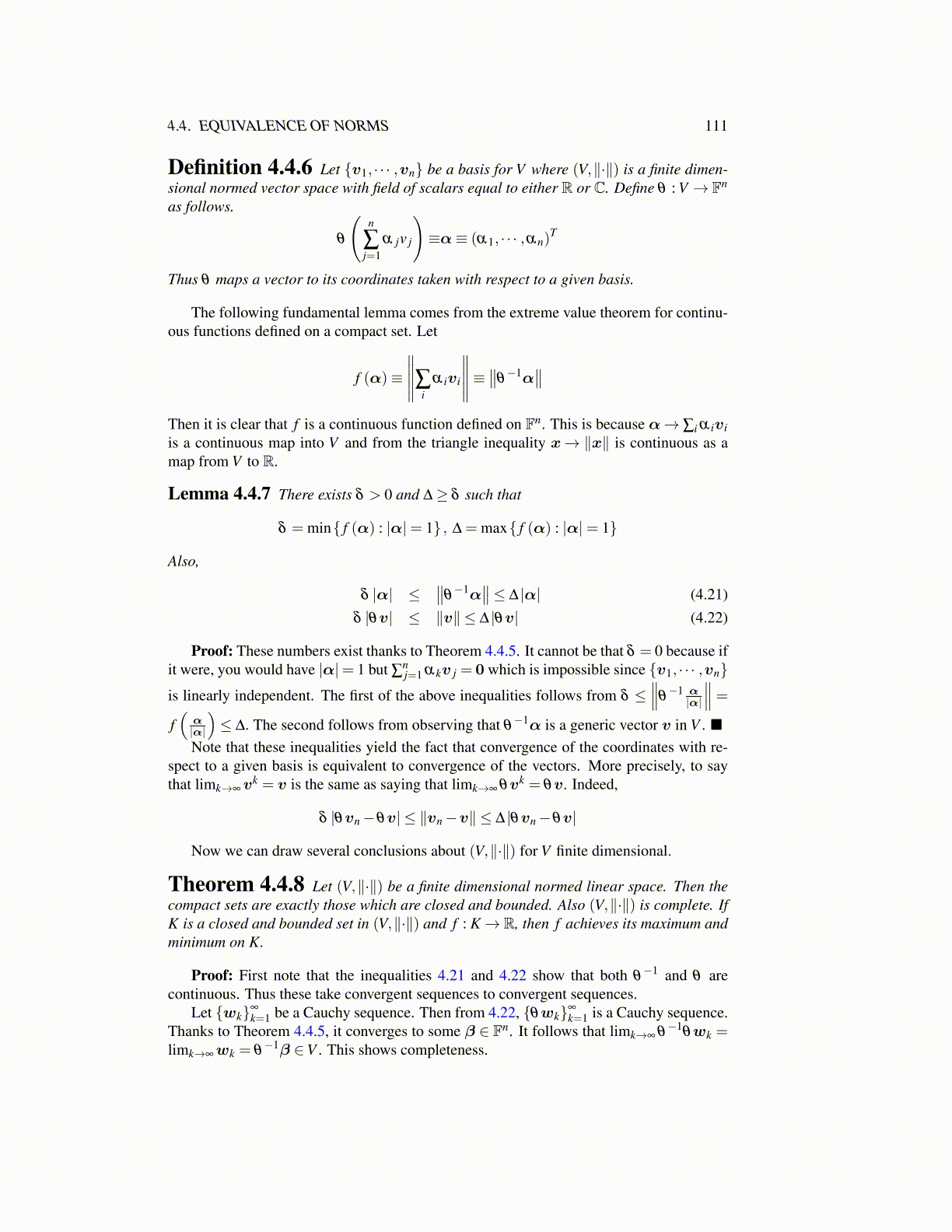
4.4. EQUIVALENCE OF NORMS 111
Definition 4.4.6 Let {v1, · · · ,vn} be a basis for V where (V,∥·∥) is a finite dimen-sional normed vector space with field of scalars equal to either R or C. Define θ : V → Fn
as follows.
θ
(n
∑j=1
α jv j
)≡α≡ (α1, · · · ,αn)
T
Thus θ maps a vector to its coordinates taken with respect to a given basis.
The following fundamental lemma comes from the extreme value theorem for continu-ous functions defined on a compact set. Let
f (α)≡
∥∥∥∥∥∑iα ivi
∥∥∥∥∥≡ ∥∥θ−1α
∥∥Then it is clear that f is a continuous function defined on Fn. This is because α→ ∑i α iviis a continuous map into V and from the triangle inequality x→ ∥x∥ is continuous as amap from V to R.
Lemma 4.4.7 There exists δ > 0 and ∆≥ δ such that
δ = min{ f (α) : |α|= 1} , ∆ = max{ f (α) : |α|= 1}
Also,
δ |α| ≤∥∥θ−1α
∥∥≤ ∆ |α| (4.21)δ |θv| ≤ ∥v∥ ≤ ∆ |θv| (4.22)
Proof: These numbers exist thanks to Theorem 4.4.5. It cannot be that δ = 0 because ifit were, you would have |α|= 1 but ∑
nj=1 αkv j = 0 which is impossible since {v1, · · · ,vn}
is linearly independent. The first of the above inequalities follows from δ ≤∥∥∥θ−1 α|α|
∥∥∥ =f(
α|α|
)≤ ∆. The second follows from observing that θ
−1α is a generic vector v in V . ■Note that these inequalities yield the fact that convergence of the coordinates with re-
spect to a given basis is equivalent to convergence of the vectors. More precisely, to saythat limk→∞v
k = v is the same as saying that limk→∞ θvk = θv. Indeed,
δ |θvn−θv| ≤ ∥vn−v∥ ≤ ∆ |θvn−θv|
Now we can draw several conclusions about (V,∥·∥) for V finite dimensional.
Theorem 4.4.8 Let (V,∥·∥) be a finite dimensional normed linear space. Then thecompact sets are exactly those which are closed and bounded. Also (V,∥·∥) is complete. IfK is a closed and bounded set in (V,∥·∥) and f : K→R, then f achieves its maximum andminimum on K.
Proof: First note that the inequalities 4.21 and 4.22 show that both θ−1 and θ are
continuous. Thus these take convergent sequences to convergent sequences.Let {wk}∞
k=1 be a Cauchy sequence. Then from 4.22, {θwk}∞
k=1 is a Cauchy sequence.Thanks to Theorem 4.4.5, it converges to some β ∈ Fn. It follows that limk→∞ θ
−1θwk =
limk→∞wk = θ−1β ∈V . This shows completeness.